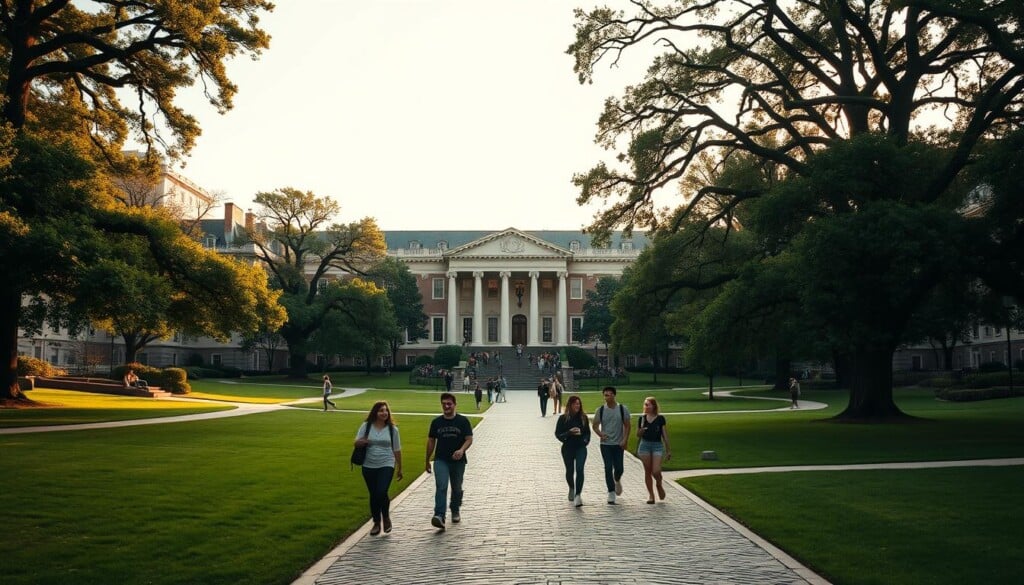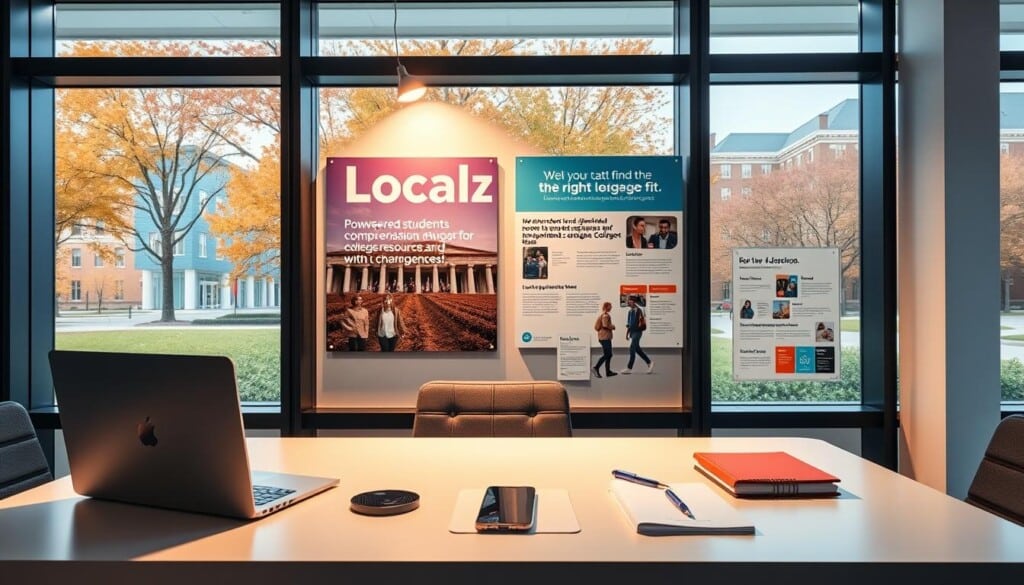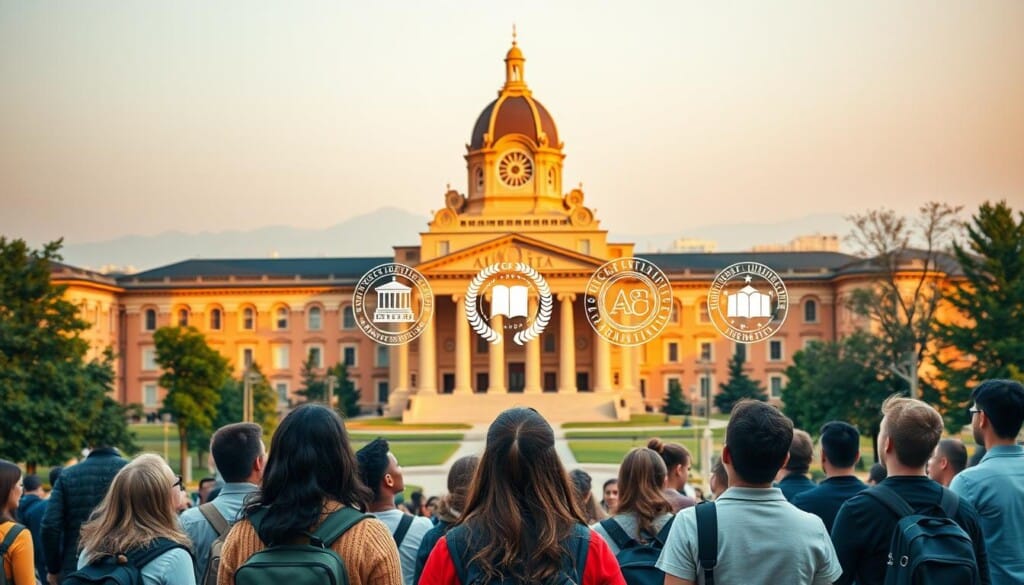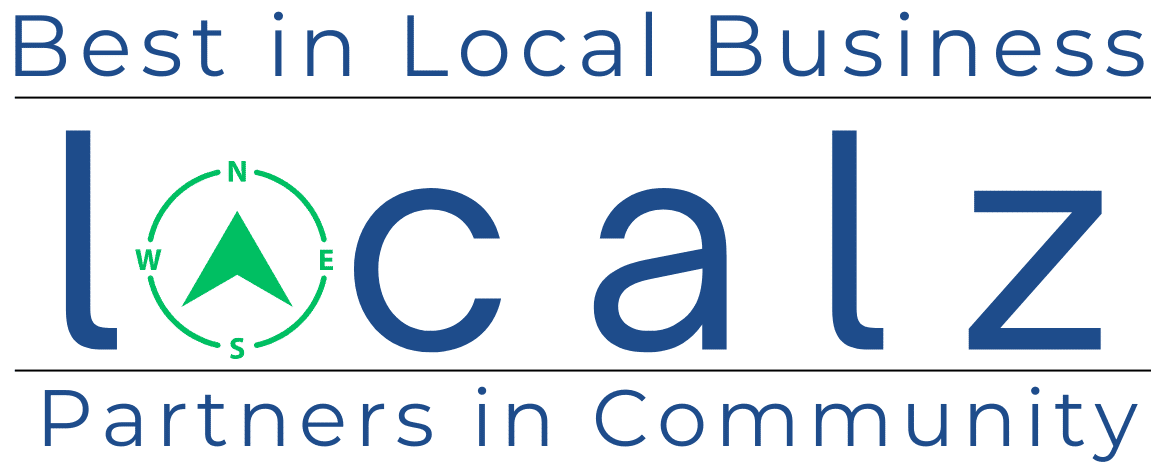As students start their higher education journey, they often wonder: What makes a college or university the best? In 2023, many institutions aim for top spots. Knowing what college rankings mean can help students choose wisely.
This section looks at the latest rankings and what they show. It covers things like admission rates, graduation rates, and faculty quality. Insights from top educational ranking sources will show the best in higher education. They will also help students think about what matters most in their choice.
Key Takeaways
- The 2023 landscape of colleges & universities features diverse academic programs across varying disciplines.
- Ranking methodologies incorporate factors such as graduation rates and faculty qualifications.
- Understanding college rankings can help students make informed decisions about their education.
- Evaluating financial resources available at institutions is critical in the decision-making process.
- Recognition from respected sources like US News & World Report boosts institutional credibility.
Overview of Higher Education Landscape in the USA
The higher education scene in the USA is changing a lot. This change is due to things like more people going to college and the economy’s effect on it. Now, more students want to study certain subjects. They also want to learn in a way that fits with today’s digital world.
Current Trends in College Enrollment
Recently, the number of students going to college has gone up and down. More people who aren’t traditional students are applying. This is because of the job market and the need for skills that employers want.
Major Areas of Study and Their Popularity
Some subjects are getting more popular, like STEM fields, business, and health. These areas match what employers need, so students are choosing them. At the same time, liberal arts are important too. They help students think critically and get a well-rounded education.
Impact of Online Learning on Traditional Colleges
Online learning has changed traditional colleges a lot. Now, they offer both online and in-person classes. More students are choosing online programs, thanks to the pandemic. Colleges are using technology to make learning easier and more flexible for everyone.
Top 10 Colleges & Universities to Consider
Higher education is filled with top colleges and universities. Harvard, Stanford, and MIT are leaders in education. They have great graduation rates and support diverse students.
Harvard University
Harvard is part of the Ivy League. It’s known for tough classes and lots of resources. With a 4% acceptance rate, it’s very selective.
Harvard offers many majors and research chances. Its alumni network is huge, adding to its fame.
Stanford University
Stanford is in Silicon Valley, known for its startup vibe. It’s very exclusive, with a 4% acceptance rate. Students get top-notch facilities and meet industry leaders.
Massachusetts Institute of Technology
MIT is a top school for engineering and tech. It accepts about 7% of applicants. MIT is known for tough classes and a culture of teamwork.
Students do lots of research, solving real problems. This makes MIT a leader in education.

These schools are leaders in education. For students looking for the best, LocalZ can help. It guides students to the best colleges for them.
Factors to Consider When Choosing a College
Choosing the right college is a big decision. It affects a student’s whole educational journey. There are many things to think about, like location, campus culture, course offerings, and financial aid.
Location and Campus Culture
The college’s location is very important. It can be close to home or in a big city or small town. This affects daily life and chances to find internships.
The campus culture also matters a lot. Things like diversity, clubs, and support for students help create a good learning environment. It should match what a student wants to achieve.
Course Offerings and Specializations
What courses a college offers is key. They should match what a student wants to do after graduation. Looking at specializations helps students find the right fit for their career goals.
Having a wide range of courses lets students customize their education. This makes their learning experience more meaningful and useful for their future.
Financial Aid and Scholarships
Money matters a lot when choosing a college. Students should look into different financial aid options. This includes federal loans, state grants, and scholarships.
Knowing about financial aid can help reduce stress about tuition. It also opens up opportunities for getting a good education without breaking the bank.
LocalZ: Connecting Students with Educational Resources
LocalZ is key for students finding their way in education. It connects those looking for educational help with local businesses. This makes finding the right college easier and more straightforward.
Students can use LocalZ to find services and support that fit their needs. It’s all done through a simple and easy-to-use website.
How LocalZ Enhances College Search Experience
LocalZ makes finding local educational resources easy. You can filter results by subject or service type. This helps students find the right help for their college search.
Whether it’s tutoring, study groups, or prep courses, LocalZ helps you find them. It’s all about making your college search simpler.
Benefits of Using LocalZ for Students
Using LocalZ has many benefits for students. It gathers a lot of educational resources in one place. Plus, it has user reviews to help you choose the best services.
These reviews give you a better idea of what to expect. They help you pick local businesses that can really help with your studies.
Engaging with Local Businesses Near Colleges
LocalZ helps students connect with local businesses. These businesses offer things like internships and fun activities. They also help with networking.
Connecting with these businesses makes college life better. It creates a sense of community that’s important for success.

Community Engagement: Colleges and Local Businesses
Colleges and local businesses work together to engage the community. This creates strong connections that help both students and the local economy. These partnerships make learning more real and valuable.
They offer internships, mentorship, and events that help students grow. These experiences are key for learning and professional development.
Examples of Partnerships Between Colleges and Local Businesses
Universities team up with local startups for internships. This gives students real-world experience. It also helps local businesses grow.
They also host events like career fairs and workshops. Businesses show their services and connect with students.
Benefits of Local Economies for Students
Working with local economies through college partnerships benefits students. They learn about the economy and help the community grow. This builds a sense of belonging.
It also prepares students for jobs after graduation. Local economies offer many opportunities.
Volunteering Opportunities for Students
Volunteering is a big part of community engagement. Colleges and local non-profits organize drives. This lets students help while learning valuable skills.
Volunteering builds empathy, teamwork, and leadership. It makes college more meaningful. Students connect with the community and businesses.
Importance of Accreditation in Higher Education
Accreditation is key in keeping education quality high. It makes sure schools follow strict standards. This process shows schools are serious about teaching well.
It’s not just about learning. Accreditation also helps students get jobs after they graduate.
Understanding the Accreditation Process
The accreditation process checks if schools meet high standards. It looks at the school’s programs, teachers, and how it runs. Schools must show they follow these rules.
This includes writing reports, getting feedback from peers, and visits from experts. It’s not just a one-time thing. Schools must keep up their standards over time.
Recognized Accrediting Agencies in the USA
In the U.S., many groups help keep education quality up. The U.S. Department of Education recognizes these groups. They help schools stay accountable and improve their reputation.
These groups include the Higher Learning Commission and the Southern Association of Colleges and Schools. They help students get federal aid and improve their job chances.

Exploring Vocational Schools and Alternative Paths
Vocational schools offer a hands-on learning experience. They prepare students for careers in specific trades. You can learn about culinary arts, welding, or automotive technology.
As job markets change, the need for skilled workers grows. This makes vocational education a great choice for quick job entry.
Comparing Vocational Schools to Traditional Colleges
Vocational schools and traditional colleges differ a lot. Vocational schools focus on specific skills and have shorter programs. They last from a few months to two years.
Traditional colleges take four years and cover more subjects. Vocational programs give targeted training that meets industry needs. This leads to a quicker job start.
Benefits of Pursuing a Trade or Technical Education
Choosing a trade or technical education has many advantages. Graduates often find jobs quickly because of their specialized skills. Programs are made with local businesses, ensuring they meet market needs.
These programs are shorter, so you can start working sooner. You’ll earn while you learn and get valuable experience. Plus, they’re often cheaper than traditional college.
Post-Graduation Opportunities for College Students
As graduation nears, students face a big change from school to work. Knowing what opportunities are out there can shape their careers. Job placement services and internships help guide them to find jobs.
Job Placement Services at Universities
Universities help students find jobs with their job placement services. They offer resume help, interview prep, and career advice. They work with local businesses to match students with jobs that fit their skills.
Networking Events and Career Fairs
Networking events and career fairs are key for students to meet employers. They can show off their skills, learn about industries, and make connections. Talking to company reps can lead to job offers and open doors for the future.
Internships and Co-op Programs
Internships and co-op programs bridge the gap between school and work. They give students real-world experience and make them more job-ready. Internships offer a peek into the industry, while co-ops often lead to job offers after graduation.
The Future of Higher Education
Technology is changing higher education fast. Tools like artificial intelligence, virtual reality, and personalized learning platforms are leading the way. They help teachers give students learning that fits them best.
These tools make learning fun and easy to get to. They make sure everyone can learn in their own way. This is good for all kinds of learners.
Innovations and Technology in Learning
Schools and universities are using new tech to teach. They use AI to check student work and give feedback right away. Virtual reality lets students explore places they can’t visit in real life.
This tech is key for getting ready for a digital world. It helps students learn in new and exciting ways.
Predictions for College Enrollment Trends
College enrollment is changing, thanks to the economy and job needs. More students want degrees that lead to jobs. This is because of the growing need for specific skills.
Online courses and hybrid learning are becoming more popular. They offer flexibility for students who can’t go to class the usual way. Schools need to find new ways to keep these students interested.
The Role of Community Colleges in Education Access
Community colleges are key for more people to get an education. They focus on being affordable and offer programs that fit local job needs. This helps more people get a chance to succeed.
By making education more accessible, community colleges help a lot of people. They play a big part in the future of higher education.

